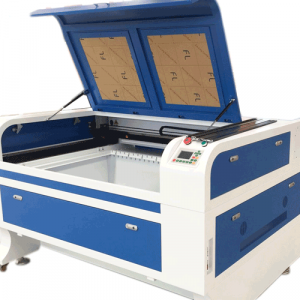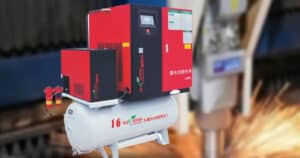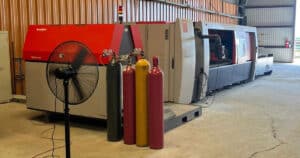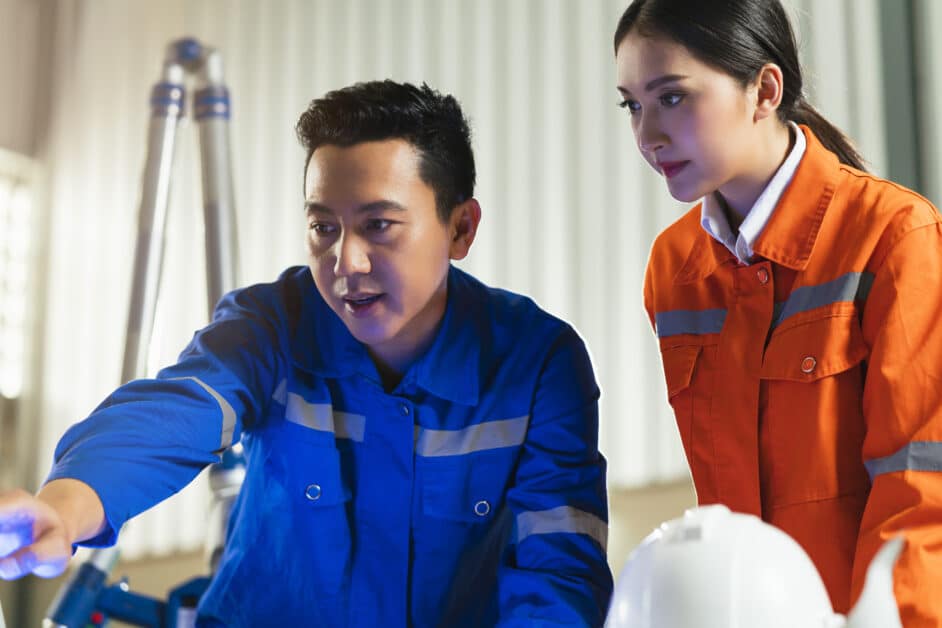Theory of laser welding
Laser welding can be realized by continuous or pulsed laser beams. The principle of laser welding can be divided into heat conduction welding and laser deep penetration welding.
The heat conduction welding occurs when the power density is less than 104 / 105 W/cm2, and the penetration is shallow and the welding speed is slow; when the power density is more than 105 / 107 W/cm2, the metal surface is sunken into a “hole” under the action of heat, forming deep penetration welding, which has the characteristics of fast welding speed and large aspect ratio.
The principle of heat conduction laser welding is as follows: the surface to be processed is heated by laser radiation, the surface heat is diffused internally through heat transfer, and the workpiece is melted by controlling the laser parameters such as laser pulse width, energy, peak power and repetition frequency. to form a specific molten pool.
The laser welding machine used for gear welding and metallurgical sheet welding is mainly related to laser deep penetration welding.
Let’s try to explain more details :
Laser deep penetration welding generally uses a continuous laser beam to connect the material, and its metallurgical physical process is very similar to that of electron beam welding, that is, the energy conversion mechanism is accomplished through the “Key-hole” structure. Under the irradiation of a high enough power density laser, the material produces evaporation and forms small holes.
The vapor-filled hole is like a blackbody, which absorbs almost all the incident beam energy. The equilibrium temperature in the cavity is about 2500 C. The heat is transferred from the outer wall of the high-temperature cavity, melting the metal around the cavity.
The keyhole is filled with high temperature steam produced by the continuous evaporation of the wall material under the light beam, and the four walls of the keyhole surround the molten metal, while the liquid metal is surrounded by the solid material (in most conventional welding processes and laser conduction welding, energy is first deposited on the surface of the workpiece and then transferred to the interior).
The liquid flow outside the hole wall and the surface tension of the wall layer are consistent with the continuous steam pressure in the cavity and maintain a dynamic balance.
The light beam continues to enter the keyhole, and the material outside the keyhole is flowing continuously. with the movement of the beam, the keyhole is always in a steady state of flow.
That is to say, the keyhole and the molten metal around the hole wall move forward with the forward speed of the leading beam, and the molten metal fills the gap left by the removal of the keyhole and condenses accordingly, and the weld is formed.
All of this happens so fast that the welding speed can easily reach a few meters per minute.
Main parameters of laser welding
Laser power
There is a laser energy density threshold in laser welding, which is lower than this value, and the penetration depth is very shallow. Once it reaches or exceeds this value, the penetration depth will be greatly increased.
Only when the laser power density on the workpiece exceeds the threshold (related to the material), the isoionic will be produced, which marks the progress of stable deep fusion welding.
If the laser power is lower than this threshold, only the surface melting of the workpiece occurs, that is, the welding is carried out in a stable heat conduction type.
When the laser power density is near the critical condition of keyhole formation, deep penetration welding and conduction welding are carried out alternately, which becomes an unstable welding process, resulting in great fluctuation of penetration depth.
In laser deep penetration welding, the laser power controls the penetration depth and welding speed at the same time.
The penetration depth of welding is directly related to the beam power density and is a function of the incident beam work rate and the beam focal spot.
Generally speaking, for a laser beam with a certain diameter, the penetration depth increases with the increase of beam power.
The focal spot of the beam
Beam spot size is one of the most important variables in laser welding because it determines the power density.
However, for high-power lasers, its measurement is a difficult problem, although there are many indirect measurement techniques.
The diffraction limit spot size of the beam focus can be calculated according to the light diffraction theory, but due to the existence of the aberration of the focusing lens, the actual spot is larger than the calculated value.
The simplest measurement method is the isothermal profile method, that is, the focal spot and perforation diameter are measured after scorching with thick paper and penetrating the polypropylene plate.
In this method, the laser power and the action time of the beam should be mastered through the measurement practice.
Material Absorption Rate
The laser absorption of the material depends on some important properties of the material, such as absorptivity, reflectivity, thermal conductivity, melting temperature, evaporation temperature and so on, the most important of which is absorptivity.
The factors that affect the absorptivity of the material to the laser beam include two aspects: first, the resistance coefficient of the material, through the measurement of the absorptivity of the polished surface of the material, it is found that the absorptivity of the material is proportional to the square root of the resistance coefficient, and the resistance coefficient varies with the temperature; secondly, the surface state of the material (or finish) has an important influence on the beam absorptivity, which has a significant effect on the welding effect.
The output wavelength of a CO2 laser is usually 10.6 μ m. The absorption rate of ceramic, glass, rubber, plastic and other non-metals is very high at room temperature, while the absorption of metal materials is very poor at room temperature, until the material is melted or even gasified, its absorption increases sharply.
By using the method of surface coating or oxide film on the surface, it is very effective to improve the light beam absorption of the material.
Welding speed
The welding speed has a great influence on the penetration depth, and increasing the speed will make the penetration shallow, but if the welding speed is too low, it will lead to excessive melting of the material and penetration of the workpiece.
Therefore, there is a suitable welding speed range for a specific material with a certain laser power and a certain thickness, and the maximum penetration depth can be obtained at the corresponding speed value.
Protective gas
Inert gas is often used to protect the weld pool in the process of laser welding, and protection can be ignored when some materials are welded regardless of surface oxidation, but helium, argon, nitrogen and other gases are often used in most applications. to protect the workpiece from oxidation in the welding process.
Helium is not easy to ionize (high ionization energy), so that the laser can pass through smoothly, and the beam energy can reach the surface of the workpiece without hindrance.
This is the most effective protective gas used in laser welding, but it is more expensive.
Argon is cheaper and denser, so the protective effect is better.
However, it is easily ionized by high temperature metal plasma, which shields part of the light beam to the workpiece, reduces the effective laser power of welding, and damages the welding speed and penetration depth.
The surface of the weldment protected by argon is smoother than that protected by helium.
Nitrogen is the cheapest protective gas, but it is not suitable for some types of stainless steel welding, mainly due to metallurgical square problems, such as absorption, sometimes produce pores in the lap zone.
The second function of using protective gas is to protect the focus lens from metal vapor contamination and liquid droplets sputtering.
Especially in high power laser welding, because the ejection becomes very powerful, it is more necessary to protect the lens.
The third function of shielding gas is to disperse the plasma shielding produced by high power laser welding.
The metal vapor absorbs the laser beam to ionize into a plasma cloud, and the protective gas around the metal vapor will also be ionized by heat.
If there is too much plasma, the laser beam is consumed by the plasma to some extent.
As the second kind of energy, plasma exists on the working surface, which makes the depth of penetration shallower and the surface of welding pool wider.
The recombination rate of electrons is increased by increasing the three-body collision between electrons and ions and neutral atoms, so as to reduce the electron density in the plasma.
The lighter the neutral atom is, the higher the collision frequency is, and the higher the recombination rate is; on the other hand, only the protective gas with high ionization energy will not increase the electron density because of the ionization of the gas itself.
The focal length of the lens.
Focusing laser is usually used in welding, and a 63~254mm (2.5 “~ 10”) focal length lens is usually selected.
The size of the focusing spot is proportional to the focal length, and the shorter the focal length is, the smaller the spot is.
However, the focal length also affects the focal depth, that is, the focal depth increases synchronously with the focal length, so the short focal length can increase the power density, but because the focal depth is small, the distance between the lens and the workpiece must be accurately maintained, and the penetration depth is not large.
Due to the influence of spatter and laser mode in the welding process, the minimum focal depth used in actual welding is mostly focal length 126mm (5 “).
When the seam is large or the weld needs to be increased by increasing the spot size, the lens with 254mm (10 “) focal length can be selected. In this case, higher laser output power (power density) is needed in order to achieve the deep penetration keyhole effect.
When the laser power exceeds the 2kW, especially for the 10.6 μ m CO2 laser beam, due to the use of special optical materials to form the optical system, in order to avoid the danger of optical damage to the focusing lens, the reflection focusing method is often selected, and the polished copper mirror is generally used as the mirror.
Because of its effective cooling, it is often recommended for high power laser beam focusing.
Focus position
In order to maintain sufficient power density, the focus position is very important in welding.
The change of the relative position between the focus and the workpiece surface directly affects the width and depth of the weld.
Figure 2-6 shows the effect of focus position on the penetration depth and seam width of 1018 steel.
In most laser welding applications, the focus is usually set at about 1×4 of the required penetration below the surface of the workpiece.
The position of the laser beam
In laser welding of different materials, the position of the laser beam controls the final quality of the weld, especially the case of butt joint which is more sensitive than that of the lap joint.
For example, when the quenched steel gear is welded to the low carbon steel drum, the correct control of the laser beam position will be beneficial to produce the weld which is mainly composed of low carbon components, which has better crack resistance.
In some applications, the geometry of the welded workpiece requires the laser beam to deflect an angle. When the deflection angle between the beam axis and the joint plane is less than 100 degrees, the absorption of laser energy by the workpiece will not be affected.
The laser power of the starting and ending points of welding is gradually increased and decreased.
In laser deep penetration welding, the keyhole phenomenon always exists regardless of the depth of the weld.
When the welding process is terminated and the power switch is turned off, pits will appear at the end of the weld.
In addition, when the laser welding layer covers the original weld, there will be excessive absorption of the laser beam, resulting in overheating or pores in the weldment.
Characteristics, advantages and disadvantages of laser welding
Characteristics of laser welding
1)The aspect ratio of height.
Because the molten metal surrounds the cylindrical high-temperature vapor cavity and extends to the workpiece, the weld becomes deep and narrow.
2) Minimum heat input.
Because the temperature in the keyhole is very high, the melting process occurs very fast, the heat input of the workpiece is very low, and the thermal deformation and heat affected zone are very small.
3) High compactness.
Because the keyhole filled with high temperature steam is conducive to weld pool stirring and gas escape, resulting in the formation of pores-free penetration weld.
The high cooling rate after welding is easy to find the microstructure of the weld.
4)Strong welding seam.
Because of the hot heat source and the full absorption of non-metallic components, the impurity content is reduced, the inclusion size and its distribution in the molten pool are changed.
No electrode or filler wire is needed in the welding process, and the melting zone is less polluted, so that the strength and toughness of the weld are at least equal to or even higher than that of the parent metal.
5) Precise control.
Because the focus spot is very small, the weld can be located with high precision.
The laser output has no “inertia” and can be stopped and restarted at high speed, and the complex workpiece can be welded by numerical control beam moving technology.
6) Non-contact atmospheric welding process.
Because the energy comes from the photon beam, there is no physical contact with the workpiece, so there is no external force to exert the workpiece.
In addition, neither magnetism nor air has any effect on the laser.
The advantages of laser welding
1) Because the focused laser has much higher power density than the conventional method, the welding speed is fast, the heat affected zone and deformation are very small, and it can also weld difficult welding materials such as titanium.
2) Because the beam is easy to transmit and control, the welding torch and nozzle do not need to be changed frequently, and there is no vacuum needed for electron beam welding, which significantly reduces the auxiliary time of downtime, so the load coefficient and production efficiency are high.
3) Due to purification and high cooling rate, the strength, toughness and comprehensive properties of the weld are high.
4) Because of the low average heat input and high machining precision, the reprocessing cost can be reduced; in addition, the running cost of laser welding is also low, thus the processing cost of the workpiece can be reduced.
5) The beam intensity and fine positioning can be effectively controlled, and it is easy to realize automatic operation.







